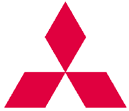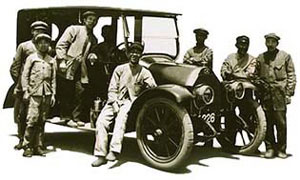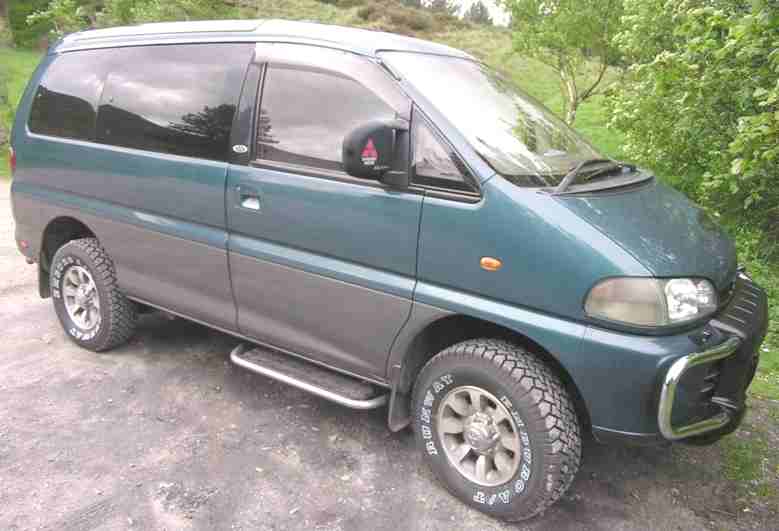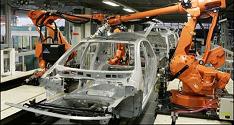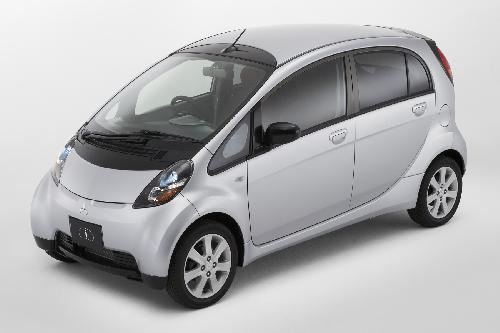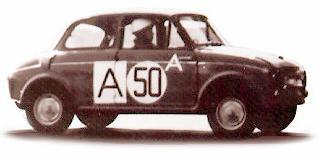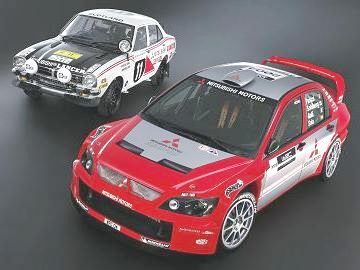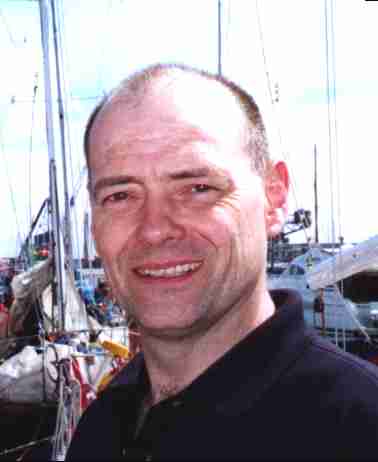|
MITSUBISHI
|
||||
|
HOME | INDEX | AUTOMOTIVE | BLUEBIRD | ELECTRIC CARS | E. CYCLES | SOLAR CARS |
||||
|
Mitsubishi Motors Corporation ( Mitsubishi Jidōsha Kōgyō Kabushiki Kaisha) is the fourth largest auto-manufacturer in Japan, and in 2006 was ranked 782nd on Forbes' list of the 2000 largest public companies. It is part of the Mitsubishi keiretsu, formerly the largest industrial group in Japan.
Background - Early history
Mitsubishi's automotive origins date back as far as 1917, when the Mitsubishi Shipbuilding Co. Ltd. introduced the Mitsubishi Model A, Japan's first series-production automobile. An entirely hand-built seven-seater sedan based on the Fiat Tipo 3, it proved expensive compared to its American and European mass-produced rivals, and production was discontinued in 1921 after only 22 had been built.
Meanwhile, in 1920, the Mitsubishi Internal Combustion Engine Co., Ltd. was established to manufacture aircraft engines. It was renamed the Mitsubishi Aircraft Co. in 1928, before being merged with Mitsubishi Shipbuilding in 1934 to create Mitsubishi Heavy Industries (MHI).
Post-war years
At the end of the Second World War, the zaibatsu (Japan's family-controlled industrial conglomerates) were dismantled by order of the Allied powers and Mitsubishi Heavy Industries was split into three regional companies, each with an involvement in motor vehicle development. The country's major need at this time was for commercial vehicles, the situation being further complicated during the first few years by a severe fuel shortage. Passenger vehicle production was confined primarily to Mitsubishi's first scooter.
By the beginning of the 1960s, however, Japan's economy was gearing up: wages were rising and the idea of family motoring was taking off. The Mitsubishi 500, a mass market sedan, was introduced to meet this demand, followed in 1962 by the Minica four-seater subcompact car, and the Colt family car. The three regional automotive companies were reintegrated as Mitsubishi Heavy Industries in 1964, and within three years their output was over 75,000 vehicles annually. Following the successful introduction of the first Galant in 1969 and similar growth with its commercial vehicle division, it was decided that the company should create a single operation to focus on the automotive industry. Mitsubishi Motors Corporation (MMC) was formed in 1970 as a wholly-owned subsidiary of MHI under the chairmanship of Tomio Kubo, a successful engineer from the aircraft division.
Workers at Mitsubishi Shipbuilding Co. Ltd alongside one of the prototype Mitsubishi Model A automobiles
Chrysler connection1970s
Part of Kubo's expansion strategy was to increase exports by forging alliances with well-established foreign companies. Therefore, in 1971 MHI sold U.S. automotive giant Chrysler a 15% share in the new company. Thanks to this deal, Chrysler began selling rebadged Galants in the United States as Dodge Colts, pushing MMC's annual production beyond 250,000 vehicles.
By 1977, a network of "Colt"-branded distribution and sales dealerships had been established across Europe, as Mitsubishi sought to begin selling vehicles directly. Annual production had by now grown from 500,000 vehicles in 1973 to 965,000 in 1978. However, this expansion was beginning to cause friction; Chrysler saw their overseas markets for subcompacts as being directly encroached by their Japanese partners, while MMC felt the Americans were demanding too much say in their corporate decisions.
1980s & MMAL
Mitsubishi finally achieved annual production of one million cars in 1980, but by this time its ally was not so healthy; As part of its battle to avoid bankruptcy, Chrysler was forced to sell its Australian manufacturing division to MMC that year. The new Japanese owners renamed it Mitsubishi Motors Australia Ltd (MMAL), and since then it has stood as the largest car production facility in the country outside of Ford and General Motors. It currently builds the Mitsubishi 380, as well as importing Chryslers and Jeeps from the U.S.
In 1982, the Mitsubishi brand was introduced to the American market for the first time. The Tredia sedan, and the Cordia and Starion coupés, were initially sold through 70 dealers in 22 states, with an allocation of 30,000 vehicles between them. This quota, restricted by mutual agreement between the two countries' governments, had to be included among the 120,000 cars earmarked for Chrysler. Toward the end of the 1980s, as MMC initiated a major push to increase its U.S. presence, it aired its first national television advertising campaign, and made plans to increase its dealer network to 340 dealers. By 1989, Mitsubishi's worldwide production, including its overseas affiliates, had reached 1.5 million units.
Diamond Star Motors
Despite the ongoing tensions between Chrysler and Mitsubishi, they agreed to unite in a vehicle manufacturing operation in Normal, Illinois. The 50/50 venture provided a way to circumvent the voluntary import restrictions, while providing a new line of compact and subcompact cars for Chrysler. Diamond Star Motors (DSM) - from the parent companies' logos: three diamonds (Mitsubishi) and a pentastar (Chrysler) - was incorporated in October 1985, and in April 1986 ground was broken on a 1.9 million square-foot (177,000 m²) production facility. In 1987, the company was selling 67,000 cars a year in the U.S., but when the plant was completed in March 1988 it offered an annual capacity of 240,000 vehicles. Initially, three platform-sharing compact 2+2 coupés were released, the Mitsubishi Eclipse, Eagle Talon and Plymouth Laser, with other models being introduced in subsequent years. The Diamond Star Coupe line was to see wild success. 1988 IPO
Mitsubishi Motors went public in 1988, ending its status as the only one of Japan's eleven auto manufacturers to be privately held. Mitsubishi Heavy Industries agreed to reduce its share to 25%, retaining its position as largest single stockholder. Chrysler meanwhile increased its holding to over 20%. The capital raised by this initial offering enabled Mitsubishi to pay off part of its debts, as well as to expand its investments throughout south-east Asia where it was by now operating in the Philippines, Malaysia, and Thailand.
Mitsubishi Delica Space Gear
1990s
Hirokazu Nakamura became president of Mitsubishi in 1989 and steered the company in some promising directions. Sales of the company's new Pajero were bucking conventional wisdom by becoming popular even in the crowded streets of Japan. Although sales of SUVs and light trucks were booming in the U.S., Japan's car manufacturers dismissed the idea that such a trend could occur in their own country. Nakamura, however, increased the budget for sport utility product development, and his gamble paid off; Mitsubishi's wide line of four-wheel drive vehicles, from the Pajero Mini keicar to the Delica Space Gear passenger van, rode the wave of SUV-buying in Japan in the early to mid-1990s, and Mitsubishi saw its overall domestic share rise to 11.6% in 1995. Independence
In 1991, Chrysler sold its equity stake in Diamond Star Motors to its partner, and from then on they continued to share components and manufacturing on a contractual basis only. Chrysler decreased its interest in Mitsubishi Motors to less than 3% in 1992, and announced its decision to divest itself of all its remaining shares on the open market in 1993. The two companies nevertheless continued their close alliance, with Chrysler supplying engines and transmissions for DSM, and Mitsubishi marketing Chrysler products overseas.
DSM was officially renamed to Mitsubishi Motor Manufacturing of America, Inc. (MMMA) on July 1st, 1995.
Other marquesHyundai
Hyundai of South Korea, now one of the most successful Tiger economy auto-makers, built the Hyundai Pony in 1975 using MMC's Saturn engine and transmissions. Korea's first car, it remained in production for thirteen years. Mitsubishi held up to a 10% stake in the company, until disposing of the last of its remaining shares in March 2003.
Proton
Proton of Malaysia was even more dependent on the Japanese company, initially only assembling their 1985 Proton Saga using MMC components at a newly established facility in Shah Alam. Subsequent models like the Wira and Perdana were based on the Lancer/Colt and Galant/Eterna respectively, before the company finally produced an entirely self-developed vehicle with 2001's Waja. At its peak, this joint venture controlled 75% of its domestic market, although Mitsubishi ended their 22-year partnership in 2005, selling their 7.9% stake for RM384 million.
Robots assembling a Smart ForFour at the NedCar facility in Born
Going Dutch with Volvo
Mitsubishi participated in a joint venture with rival truck-maker Volvo and the Dutch government at the former DAF plant in Born in 1991. The operation, branded NedCar, began producing the first generation Mitsubishi Carisma alongside the Volvo S40/V40 in 1996.
The Dutch government sold out to its partners in 1999 and Volvo, by now owned by Ford, sold its stake to Mitsubishi in early 2001 to leave the Japanese company as the only remaining shareholder.
The factory currently produces the latest Mitsubishi Colt and Smart Forfour super minis, although Daimler-Chrysler has cancelled production of the Smart and recent output has been declining. With layoffs confirmed for 2007 and no guarantee of future models being built here, NedCar's future remains in the balance.
Colt & Lonsdale
The Colt name appears frequently in Mitsubishi's history since its introduction as a rear-engined 600cc sedan in the early 1960s. Today, it most commonly refers to the Mitsubishi Colt subcompact in the company's line-up, but is also the name of MMC's import/distribution company in the United Kingdom, established in 1974. For the first decade of its existence, before Far Eastern auto manufacturers had established their reputations, its cars carried the "Colt" badge in Britain instead of "Mitsubishi".
In 1982 & '83, Mitsubishi introduced the Australian-built Chrysler Sigma to the UK as the Lonsdale Sigma in an attempt to circumvent British import quotas, but the new brand was unsuccessful. It then carried Mitsubishi Sigma badges in 1983–84 before abandoning this operation entirely.
Recent troubles
Sexual harassment suits
Mitsubishi's image in North America was tarnished when two notable lawsuits were brought against the company. The first, filed by 29 women in December 1994, accused the company of fostering a climate of sexual harassment at its Normal, Illinois plant. Then, in April 1996 the Equal Employment Opportunity Commission (EEOC) filed a class action suit on behalf of approximately 300 other women who worked at the plant. Mitsubishi initially denied any problems at its plant but later hired former U.S. Labor Secretary Lynn Martin to recommend changes to its policies and practices. The 1994 suit was settled for US$9.5 million in August 1997, and reached an agreement with the EEOC later that year as well.
Asian economic downturn
The benefits Mitsubishi had seen because of its strong presence in south-east Asia reversed themselves as a result of the economic crisis in the region which began in 1997. In September of that year the company closed its Thai factory in response to a crash in the country's currency and plummeting consumer demand. The large truck plant, which had produced 8,700 trucks in 1996, was shut down indefinitely. In addition, Mitsubishi had little support from sales in Japan, which slowed considerably throughout 1997 and were affected by that country's own economic uncertainty into 1998. Other Japanese automakers, such as Toyota and Honda, bolstered their own slipping domestic sales with success in the U.S. However, with a comparatively small percentage of the American market, the impact of the turmoil in the Asian economy had a greater effect on Mitsubishi, and the company's 1997 losses were the worst in its history. In addition, it lost both its rank as the third largest automaker in Japan to Mazda, and market share overseas. Its stock price fell precipitously, prompting the company to cancel its year-end dividend payment.
In November 1997, Mitsubishi hired Katsuhiko Kawasoe to replace Takemune Kimura as company president. Kawasoe unveiled an aggressive restructuring program that aimed to cut costs by ¥350 billion in three years, reduce personnel by 1,400, and return the company to profitability by 1998. But while the program had some initial success, the company's sales were still stagnant as the Asian economy continued to sputter. In 1999, Mitsubishi was forced once again to skip dividend payments. Its interest-bearing debt totaled ¥1.7 trillion.
Vehicle defect cover-up
Mitsubishi was twice forced to admit to covering up defect problems in its vehicles. Four defects were first publicized in 2000, but in 2004 it confessed to 26 more going back as far as 1977, including failing brakes, fuel leaks and malfunctioning clutches. The effect on the company was catastrophic, forcing it to recall 163,707 cars (156,433 in Japan and 7,274 overseas) for free repair. Further recalls by Fuso truck & bus brought the total number of vehicles requiring repair to almost one million. The scandal led to the resignation of Kawasoe and his subsequent arrest, along with 23 other employees who were also implicated.
0–0–0
In an effort to boost sales in the U.S. at the start of the decade, Mitsubishi began offering a "0–0–0" finance offer – 0% down, 0% interest, and $0 monthly payments (all repayments deferred for 12 months). Initially, sales leapt, but at the end of the year's 'grace period' numerous credit-risky buyers defaulted, leaving Mitsubishi with used vehicles for which they'd received no money and which were now worth less than they cost to manufacture. The company's American credit operation, MMCA, was eventually forced to make a US$454 million provision against its 2003 accounts as a result of these losses.
The new Mitsubishi i keicar
Australian production
In October 2005, MMC introduced the Mitsubishi 380 to the Australian market as the replacement for its long-running Mitsubishi Magna, and the sole vehicle being built at its Australian assembly plant at Clovelly Park. Despite an investment of AU$600 million developing the car, initial sales projections have so far proven optimistic; after only six months Mitsubishi scaled back production from 90/day, and reduced the working week from five days to four. It is still unknown whether this will be sufficient to restore the plant to profitability and ensure its long term survival.
Daimler Chrysler relations
Two years after the merger of Daimler and Chrysler to form DCX, the U.S.-German conglomerate paid US$1.9 billion for a controlling 34% of MMC in an effort to create a "Welt AG" (global automaker). The price reflected a US$200 million discount on the originally agreed figure, caused by the public disclosure of the defect cover-up scandal. In March 2001 it increased this to 37.3% when it acquired Volvo's stake in MMC's truck-making operations, further boosting Mercedes' share of a market it already dominated. However, boardroom wrangles at DCX prevented them offering financial assistance as Mitsubishi attempted to reduce its crippling debts.[10] When a US$4 billion rescue package was agreed with Tokyo-based Phoenix Capital in May 2004, DCX's stake was reduced to 23%, and further recapitalisations subsequently diluted the holding to 12.4%. Finally, on 11th November 2005, the remaining stock was sold for US$1.1 billion – an US$800 million loss in five years.[11] Three days later the buyer, investment bank Goldman Sachs sold the shares on for US$80 million profit.
New major stockholder Phoenix Capital followed suit the following month, selling all but 50 million of its 575 million shares to J P Morgan on 9th December 2005. Once again, the investment bank offloaded their purchase within a few days for tens of millions in profit. In both cases, the eventual buyers were part of the Mitsubishi keiretsu, returning MMC to Japanese ownership once more. However, whether this improves its chances of long-term survival is still unknown.
Recovery strategy
The current president, Osamu Masuko, is hoping for a return to the black in the 2006 financial year and a reversal of the worldwide decline in sales. The company reported its first profitable quarter in the third quarter of 2005 after eleven successive losses, thanks in part to a weaker yen, and reduced charges to cut bad loans and write down asset values. After a starvation of new investment caused by their cashflow crises, the company introduced the Mitsubishi i keicar, its first new model in 29 months. A new generation Outlander/Airtrek will be introduced in the U.S. to compete in the popular XUV market niche, joining the new Eclipse, Lancer and Lancer Evolution X in its most critical territory.
Meanwhile, slow-selling vehicles like the Diamante, Lancer Sportback station wagon, Montero Sport and U.S.-market Montero have all been discontinued. Purchase projections for the Mitsubishi/Hyundai/Chrysler Global Engine Manufacturing Alliance engines have been scaled back. 10,000 jobs have been shed to cut costs, with 3,400 workers at its Australian plant and other loss-making operations still under threat. Meanwhile, new export markets for the Eclipse and Galant in Russia, Ukraine and the Middle East are being explored, in an effort to increase production at its U.S. facility. Mitsubishi has also been active in OEM production of cars for Nissan, and announced a partnership with PSA Peugeot Citroën in July 2005 to manufacture an SUV. The company's global target is 1,524,000 sales by the end of the 2007 fiscal year.
Motorsport
Mitsubishi has almost half a century of international motorsport experience, predating even the incorporation of MMC. Beginning with street races in the early 1960s, the company found itself gravitating towards the challenge of off-road racing. It dominated the East African Safari Rally in the '70s, the Dakar Rally from the '80s, and the Group A and Group N classes of the World Rally Championship through the '90s.
Mitsubishi's first racing car - the 500 Super DeLuxe
Mitsubishi 500 Super DeLuxe – Mitsubishi entered the 1962 Macau Grand Prix in an effort to promote sales of its first passenger vehicle since the end of the Second World War. In an auspicious debut, the diminutive rear-engined sedan swept the top four places in the "Under 750 cc" category, with Kazuo Togawa taking class honours.
Colt 600 – Demand for Mitsubishi products boomed in the wake of the Macau victory, and the Colt 600 was developed to exploit this new market. Based on the 500 but with a larger engine and redesigned rear, it swept the podium in the 1963 Malaysian GP with a 1-2-3 in the "Under 600 cc" class. Colt 1000 – In its final year of competition with Touring Cars, Mitsubishi scored another clean sweep of the podium, this time in the 1964 Japanese GP. The 1000, their first front-engined competition vehicle, dominated the "750-1000 cc" class.
Formula racing – Mitsubishi began concentrating on open-wheeled racers for the remainder of the '60s, as the Japanese GP grew in popularity. Their F3A was a 1000 cc OHV, and won the "Exhibition" class in 1966. The following year, with a bored-out 1600 cc OHV F2A, they scored a class 1-2 with drivers Mochizuki and Osamu Masuko. Another Japan GP class 1-2 was Mitsubishi's in 1968 with a DOHC 1600 cc F2B, while the F2C & F2D, devloped to keep pace with aerodynamic innovations of the era, scored further podiums in 1969-70. They finished on a high with success in the 1971 Japan GP with the two litre DOHC F2000, before taking their expertise off-tarmac.
Lancer 1600 GSR – The East African Safari Rally was by far the most gruelling event on the WRC calendar in the '70s. MMC developed the 1600 GSR specifically for the marathon race, and won at the first attempt in 1974. Even more impressively, they achieved a clean sweep of the podium places in 1976, a remarkable feat in an event where only 20% of the starters typically reached the finish. They also achieved a 1-2-3-4 in the 1973 Southern Cross Rally, the first of four consecutive victories in this event with drivers Andrew Cowan and Kenjiro Shinozuka.
Galant VR-4, Lancer Evolution (Group A) – After scoring its first outright WRC victories with a Galant in the late '80s, Mitsubishi homologated the Lancer, and in the hands of Finland's Tommi Makinen, winner of the Drivers' title for four consecutive years (1996-1999), they won the Manufacturers' Championship in 1998. They have won 34 WRC events since 1973.
Lancer Evolution (Group N) – The Lancer Evo has utterly dominated the FIA championship for showroom-ready cars, winning seven consecutive titles with four different drivers from 1995-2001. Even in 2002 when it ostensibly lost the title, the class-winning manufacturer was Proton, using a Lancer Evo-based Pert.
Pajero – Mitsubishi is the most successful manufacturer in the history of the Dakar Rally, one of the most challenging and dangerous motorsport events in the world. MMC's maiden entry was in 1983, and it took only three attempts to find a winning formula. Since then, they have won in 1992, '93, '97, '98, and '01-'06, an unprecedented six consecutive victories and the eleventh overall with nine different drivers.
Jackie Chan
Mitsubishi has a long association with movie star Jackie Chan, who has always used their vehicles in his movies. The Jackie Chan Cup is an annual celebrity auto race involving starlets from across Asia in Mitsubishis with professional Touring Car drivers alongside for assistance, and was held before the Macau GP until 2004 when it moved to Shanghai.[17] And in September 2005 Ralliart, Mitsubishi's motorsport arm, produced 50 Jackie Chan Special Edition versions of the Lancer Evo IX; Chan acts as the honorary Director of Team Ralliart China.
Controlling shareholders
Total for the three Mitsubishi Group companies: 1,847,377 (34.18%) as of 31 Dec 2005
Mitsubishi's most significant rally cars: Lancer 1600 GSR (left) Lancer Evo WRC (right)
LINKS and REFERENCES
Corporate history at Mitsubishi Motors' global website Corporate history at Mitsubishi Motors' UK website Corporate history at Mitsubishi Motors' South African website History of Mitsubishi at fundinguniverse.com Mitsubishi Motors entry in Forbes 2006 list of largest public companies "Mitsubishi to sell stake in Hyundai", Andrea Wielgat, Automotive Industries, November 2002 "Mitsubishi sells entire stake in Proton", Yoshifumi Takemoto & Chan Tien Hin, Bloomberg News, 13 January, 2005 "Agreement ends strikes at NedCar", Expatica.com, 25 April 2006 "MMNA and EEOC reach voluntary agreement to settle harassment suit", EEOC press release, 11 June 1998 "Mitsubishi Motors Admits Decades-Long Defect Cover-Up" Autosafety.org / Associated Press, 2 June 2004 "Cover-up forces Mitsubishi boss out" BBC News, 8 September 2000 "Mitsubishi Motors Announces First-Half FY 2003 Results, Gives Forecast for Full-Year FY 2003" Mitsubishi Motors press release, 11 November 2003 "Mitsubishi cuts back daily 380 output", Brian Littlely, The Advertiser, 24 April 2006 "Remodelling Japan Inc" Sarah Buckley, BBC News, 13 October 2004 "Daimler sells stake in Mitsubishi" BBC News, 11 November 2005 "Mitsubishi shares make Goldman Sachs $80 million in a day" Automotive Business Review, 18 November 2005 "Mitsubishi’s turnaround hinges on new models, worker mindset" AIADA, 31 October 2005 World Rally Championship for Manufacturers at Rallybase.nl website FIA Cup for Drivers of Production Cars at Rallybase.nl website "Mitsubishi achieves record-breaking fifth victory and 10th overall win on the Dakar Rally" Mitsubishi Motors press release, 17 January 2005 Jackie Chan Foundation will hold their next annual auto race in Shanghai Jackiechankids.com news release, 1 November 2003 "Jackie Chan kicks back" New Zealand Herald, 10 September 2005 "FASC Chinese Team Complete Support of Team Mitsubishi Ralliart China" Jackiechankids.com news release, 22 December 2003 Stock Information Mitsubishi Motors website Mitsubishi Motors South Africa
A - Z DIRECTORY of CARS
Please click on the links above to find out about these famous automotive makers. If your company is not included and you would like to be listed, please let us know.
UK VEHICLE INSURANCE ONLINE
The well known designer of exotic vehicles such as the Borzoi and the Bluebird Electric series, knows when he's on to a good thing. Nelson previously insured his vehicles with the Royal for about 10 years then General Accident for another 10 years. Which proves we tend to be loyal to our insurers - but are they loyal in return? These days it pays to shop around.
Nelson Kruschandl - "Great value and service."
About four years ago Nelson's policy went up by about 30% at which point he decided to check out the market. He obtained quotations from most of the firms advertising savings online such as Churchill, Morethan and Direct Line, but was pleasantly surprised to find his local company could beat the best quote he'd obtained by quite a bit and offer a better policy. Sold. Nelson says: "Why don't you give Hastings Direct a try online and help us maintain this site." It won't cost you a penny more, but it will help us out a lot. For every policy sold through us, Hastings Direct will contribute to our running costs - so please mention us.
A taste for adventure capitalists
Solar Cola - a healthier alternative
|
||||
|
AUTOMOTIVE | EDUCATION | SOLAR CAR RACING TEAMS | SOLAR CAR RACING TEAMS | SOLAR CARS |
||||
|
The content
of this website is copyright © 1991 and 2006
Electrick Publications. All rights reserved. The bluebird logo |
